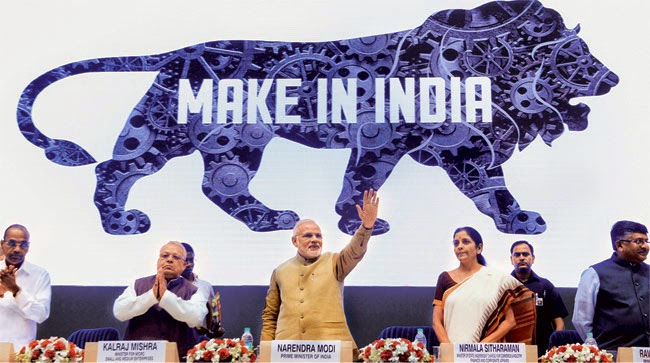Launched on -: 25th September, 2014
Objective -: "A MAJOR NEW NATIONAL PROGRAM. DESIGNED TO FACILITATE INVESTMENT. FOSTER INNOVATION. ENHANCE SKILL DEVELOPMENT. PROTECT INTELLECTUAL PROPERTY. AND BUILD BEST-IN-CLASS MANUFACTURING INFRASTRUCTURE."
.
Sectors(25) -: AUTOMOBILES, AUTOMOBILE COMPONENTS, AVIATION, BIOTECHNOLOGY, CHEMICALS, CONSTRUCTION, LEATHER, DEFENCE MANUFACTURING, ELECTRICAL MACHINERY, ELECTRONIC SYSTEMS, FOOD PROCESSING, IT AND BPM, MEDIA AND ENTERTAINMENT, MINING, OIL AND GAS, PHARMACEUTICALS, PORTS, RAILWAYS, RENEWABLE ENERGY, ROADS AND HIGHWAYS, SPACE, TEXTILES AND GARMENTS, THERMAL POWER, TOURISM AND HOSPITALITY, WELLNESS
Vision Of MII
- An increase in manufacturing sector growth to 12-14% per annum over the medium term.
- An increase in the share of manufacturing in the country’s Gross Domestic Product from 16% to 25% by 2022.
- To create 100 million additional jobs by 2022 in manufacturing sector.
- Creation of appropriate skill sets among rural migrants and the urban poor for inclusive growth.
- An increase in domestic value addition and technological depth in manufacturing.
- Enhancing the global competitiveness of the Indian manufacturing sector.
- Ensuring sustainability of growth, particularly with regard to environment.
Theory behind “Make in India”(MII)
- MII will eventually take up policy reforms involving changes in laws to ensure ease of doing business in the country.Starting a business in India at present needs an entrepreneur to follow 12 procedures, which on an average takes 27 days,these need to be streamlined.
- The objective is to take manufacturing growth to 10% on a sustainable basis. For this The Department of Industrial Policy and Promotion has set up an eight-member expert panel to redress grievances and handle queries of global and domestic investors within 24 hours.
- The campaign includes invitations to the world’s top 3,000 companies to explore investment possibilities in India. For the launch, the government is likely to invite the who’s who of the global corporate sector from the U.S., Japan, Korea, Sweden, Poland, Australia, China, Italy, Germany and France.
- Most importantly, the Make in India program represents an attitudinal shift in how India relates to investors: not as a permit-issuing authority, but as a true business partner.
RECENT POLICY MEASURES
- 100% FDI allowed in the telecom sector.
- 100% FDI in single-brand retail.
- FDI in commodity exchanges, stock exchanges & depositories, power exchanges, petroleum refining by PSUs, courier services under the government route has now been brought under the automatic route.
- Removal of restriction in tea plantation sector.
- FDI limit raised to 74% in credit information & 100% in asset reconstruction companies.
- FDI limit of 26% in defence sector raised to 49% under Government approval route. Foreign Portfolio Investment up to 24% permitted under automatic route. FDI beyond 49% is also allowed on a case to case basis with the approval of Cabinet Committee on Security.
- Construction, operation and maintenance of specified activities of Railway sector opened to 100% foreign direct investment under automatic route.
AUTOMATIC ROUTE :
Under this route no Central Government permission is required.
GOVERNMENT ROUTE :
- Under this route applications are considered by the Foreign Investment Promotion Board (FIPB). Approval from Cabinet Committee on Security is required for more than 49% FDI in defence. The proposals involving investments of more than INR 12 billion are considered by Cabinet committee on economic affairs.
- The Indian company receiving FDI either under the automatic route or the government route is required to comply with provisions of the FDI policy including reporting the FDI and issue of shares to the Reserve Bank of India.
What MII can do?
- Global manufacturing hub
- It will enhance job opportunities within the country.
- It will minimisze the imports of such products into the country, thereby mitigating the pressure on our trade deficit.
- In the long run, if not in the near-term, it will help augment and diversify our exports from the manufacturing sector.
- It will help in bringing latest technologies into the countryand.
- Such domestic manufacturing will help minimize some of the trade frictions we have with other countries.
2. Competitive environment
- It will encourage domestic manufacturing of world-class standards.
- It will create an environment that makes our firms able to compete with the rest of the world, and encourages foreign producers to come take advantage of our environment to create jobs in India.
3. Ensure IPR(intellectual property rights) protection
- It will Establish a vibrant IP regime in the country.
- Efficient processing of IP applications by inducting additional manpower, augment IT facilities and automation in Intellectual Property Offices.
- Adopt best practices in IP processing.
- Strengthening public delivery of IP services.
- Highest levels of transparency and user-friendliness.
Hurdles In MII
Three L's
LAW
- There is less transparent law and instability in rules, One Vodafone case is enough to make oversees investors shy away.
LAND
- The problem of Land Acquisition. The abortive foray by the Tatas to make Nano cars in West Bengal, the escalating tension over land acquisition by SEZs (special economic zones) and the like have ensured that Corporate India thinks many times over before venturing into any greenfield project.
LABOUR
- After laws and land, labour is an important clog in the wheel. In an increasingly globalised economy, jobs tend to move towards one direction, that is, where the labour is cheap. India has cheap labour then where the problem lies? the answer is Archaic labour laws that proved a strong deterrent for any overseas company to set shop in India.




